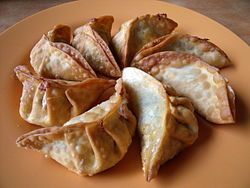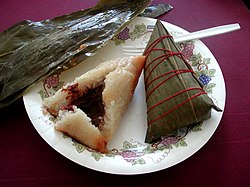Dumpling

| |
| Singapore fried dumplings | |
| Alternative names | |
| Type | |
| Course | |
| Place of origin | Chinese |
| Region or state | |
| Associated national cuisine | |
| Created by | |
| Invented | |
| Cooking time | minutes to minutes |
| Serving temperature | |
| Main ingredients | Flour, potatoes or bread |
| Ingredients generally used | |
| Variations | |
| Food energy | kcal |
| Nutritional value | Protein: g, Fat: g, Carbohydrate: g |
| Glycemic index | |
| Similar dishes | |
| Other information | |
| Website | [ Official website] |

Dumpling[edit]

Dumplings may be any of a wide variety of dishes, both sweet and salty, in several different cuisines. They are either made from balls of dough or are small bits of food put into pastry, dough, batter, or leaves
A dumpling is a versatile and delicious food item that is found in various cuisines around the world. It is typically made by wrapping dough around a filling and then cooking it through various methods such as boiling, steaming, frying, or baking. Dumplings come in a wide variety of shapes, sizes, and flavors, making them a popular choice for appetizers, main courses, or even desserts.
History[edit]
The exact origins of dumplings are uncertain, as they have been a part of different cultures for centuries. However, dumplings are believed to have originated in China around 1,800 years ago during the Eastern Han Dynasty. From there, they spread to other Asian countries like Japan, Korea, and Vietnam, and eventually made their way to Europe and the Americas through trade routes and immigration.
Types of Dumplings[edit]
There are numerous types of dumplings, each with its own unique characteristics and preparation methods. Here are a few notable examples:
Chinese Dumplings[edit]

Chinese dumplings, known as jiaozi or dim sum, are perhaps the most well-known type of dumplings worldwide. They are typically filled with a combination of minced meat (such as pork or chicken), vegetables, and seasonings. Chinese dumplings can be steamed, boiled, or pan-fried, and are often served with a dipping sauce.
Japanese Dumplings[edit]
In Japan, dumplings are called gyoza and are a popular appetizer or side dish. Japanese gyoza are usually filled with ground meat (such as pork or chicken), cabbage, garlic, ginger, and soy sauce. They are typically pan-fried until crispy on the bottom and then steamed to ensure they are cooked through.
Italian Dumplings[edit]

Italy has its own variation of dumplings called gnocchi. These dumplings are made from a mixture of mashed potatoes, flour, and eggs. Gnocchi are shaped into small pillows and then boiled or pan-fried. They are commonly served with various sauces, such as tomato sauce, pesto, or butter and sage.
Cultural Significance[edit]
Dumplings hold significant cultural importance in many countries. They are often associated with festivals, celebrations, and family gatherings. In Chinese culture, for example, dumplings are a traditional food served during the Chinese New Year as a symbol of wealth and good fortune. In other cultures, dumplings may have specific meanings or rituals associated with them.
Dumpling Festivals[edit]
Dumpling festivals are vibrant and joyful celebrations that highlight the cultural significance of dumplings in various parts of the world. These festivals often feature an array of dumpling varieties, cooking demonstrations, cultural performances, and interactive activities. Here are a few notable dumpling festivals:
Dragon Boat Festival (China)[edit]

The Dragon Boat Festival, also known as Duanwu Festival, is a traditional Chinese holiday celebrated on the fifth day of the fifth lunar month. One of the main highlights of this festival is the consumption of zongzi, a special type of sticky rice dumpling. Zongzi are made by wrapping glutinous rice with various fillings, such as pork, beans, or nuts, in bamboo leaves. They are then steamed or boiled for several hours. The Dragon Boat Festival is not only an opportunity to enjoy zongzi but also to participate in dragon boat races and other cultural activities.
Pierogi Festival (Poland)[edit]

Poland is famous for its dumplings called pierogi. The city of Krakow hosts an annual Pierogi Festival, which celebrates this beloved Polish delicacy. During the festival, streets are filled with vendors selling a wide variety of pierogi, including traditional fillings like potato and cheese, sauerkraut and mushroom, and sweet options like fruit-filled pierogi. The festival also features live music, folk dances, and cooking competitions, attracting both locals and tourists alike.
Momo Festival (Nepal and India)[edit]

Momo is a type of dumpling that originated in Tibet and has become immensely popular in Nepal, India, and other South Asian countries. The Momo Festival celebrates this savory delight and showcases different momo variations from various regions. The festival offers a chance to savor steamed or fried momos filled with diverse fillings like meat, vegetables, cheese, or chocolate. Alongside the delicious momos, the festival also includes live music, dance performances, and cultural exhibitions.
Culinary Techniques[edit]
The process of making dumplings involves several culinary techniques, depending on the type and style of dumpling. Here are some common techniques used in dumpling preparation:
Wrapping and Filling[edit]

To make dumplings, a dough is typically prepared by combining flour, water, and sometimes additional ingredients like eggs or oil. The dough is then rolled out and cut into small circles or squares, depending on the desired shape of the dumpling. The filling, which can consist of meat, vegetables, seafood, or a combination of ingredients, is placed in the center of each dough piece. The edges of the dough are then sealed by folding or crimping, creating a pouch that encloses the filling.
Cooking Methods[edit]
Dumplings can be cooked using various methods, each imparting a unique texture and flavor. Some common cooking techniques include:
Boiling: Dumplings are immersed in boiling water and cooked until they float to the surface. This method is often used for delicate dumplings with thin wrappers.
Steaming: Dumplings are placed in a steamer basket and cooked using steam. Steaming helps retain the moisture and flavors of the fillings, resulting in tender and juicy dumplings.
References[edit]
<references> Smith, J. (2019). The Dumpling: A Seasonal Guide. Food & Wine Magazine. Retrieved from [1] Lee, J. (2021). The Illustrated Dumpling Guide: Everything You Need to Know About Dumplings. Serious Eats. Retrieved from [2] Chan, J. (2020). Dumplings of the World. The Spruce Eats. Retrieved from [3] </references>
Ad. Transform your life with W8MD's Budget GLP-1 injections from $75


W8MD offers a medical weight loss program to lose weight in Philadelphia. Our physician-supervised medical weight loss provides:
- Weight loss injections in NYC (generic and brand names):
- Zepbound / Mounjaro, Wegovy / Ozempic, Saxenda
- Most insurances accepted or discounted self-pay rates. We will obtain insurance prior authorizations if needed.
- Generic GLP1 weight loss injections from $75 for the starting dose.
- Also offer prescription weight loss medications including Phentermine, Qsymia, Diethylpropion, Contrave etc.
NYC weight loss doctor appointmentsNYC weight loss doctor appointments
Start your NYC weight loss journey today at our NYC medical weight loss and Philadelphia medical weight loss clinics.
- Call 718-946-5500 to lose weight in NYC or for medical weight loss in Philadelphia 215-676-2334.
- Tags:NYC medical weight loss, Philadelphia lose weight Zepbound NYC, Budget GLP1 weight loss injections, Wegovy Philadelphia, Wegovy NYC, Philadelphia medical weight loss, Brookly weight loss and Wegovy NYC
|
WikiMD's Wellness Encyclopedia |
| Let Food Be Thy Medicine Medicine Thy Food - Hippocrates |
Medical Disclaimer: WikiMD is not a substitute for professional medical advice. The information on WikiMD is provided as an information resource only, may be incorrect, outdated or misleading, and is not to be used or relied on for any diagnostic or treatment purposes. Please consult your health care provider before making any healthcare decisions or for guidance about a specific medical condition. WikiMD expressly disclaims responsibility, and shall have no liability, for any damages, loss, injury, or liability whatsoever suffered as a result of your reliance on the information contained in this site. By visiting this site you agree to the foregoing terms and conditions, which may from time to time be changed or supplemented by WikiMD. If you do not agree to the foregoing terms and conditions, you should not enter or use this site. See full disclaimer.
Credits:Most images are courtesy of Wikimedia commons, and templates, categories Wikipedia, licensed under CC BY SA or similar.
Translate this page: - East Asian
中文,
日本,
한국어,
South Asian
हिन्दी,
தமிழ்,
తెలుగు,
Urdu,
ಕನ್ನಡ,
Southeast Asian
Indonesian,
Vietnamese,
Thai,
မြန်မာဘာသာ,
বাংলা
European
español,
Deutsch,
français,
Greek,
português do Brasil,
polski,
română,
русский,
Nederlands,
norsk,
svenska,
suomi,
Italian
Middle Eastern & African
عربى,
Turkish,
Persian,
Hebrew,
Afrikaans,
isiZulu,
Kiswahili,
Other
Bulgarian,
Hungarian,
Czech,
Swedish,
മലയാളം,
मराठी,
ਪੰਜਾਬੀ,
ગુજરાતી,
Portuguese,
Ukrainian
